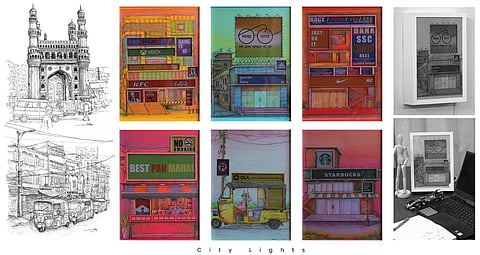

HYDERABAD: Bolgum Sai Aditya, an architect and a designer, shared his learnings and insights with students of Jawaharlal Nehru Architecture and Fine Arts University (JNAFAU) on Tuesday. He shared his work and projects he undertook as a student of Master of Design at NID, Ahmedabad. The Vice-Chancellor, Kavita D Rao, the principals of JNAFAU and JNAFAU-SPA, directors of various departments, the faculty members and the students attended the event.
“I was completely bowled over by the work he has been doing. We are trying to initiate a journey into innovation for our university. Innovation is a less-liked word in our community as it is currently being used by the computer and digital world. In our field innovation is equally important but not realised and recognised so much because we feel that each design is our innovation. However, we need to focus more on innovation. That is one reason why Sai Aditya has been invited today to share his insights,” said Kavita Rao.
The lecture was focused on innovation using customisation and crafts to enable design for multifaceted purposes. His work on designing customised furniture for an individual as well as for masses at NID was shared. “Innovation simply means observing your surroundings and finding solutions to problems. For me, the core principle as a designer is that innovate with technology. My passion for art and craft enables it. I do a lot of research before making my products,” said Bolgum Sai Aditya.
He emphasised the fact that technology is important in innovation as it is what the market demands these days. Showing students three different products, he shed light on recycling, using eco-friendly raw materials and making customised products. He also introduced the ‘Alexander technique’, wherein physical body postures and body movements guide a designer to make customised and functional designs. “A bad body posture will impact your health in the long run. While using a phone, it is important to keep your neck and back in a straight line while eyes and hands should be moved around for better use,” Aditya said.
Connecting how body movements allow one to customise and design furniture for individual use, he said that innovation in the age of customisation is not about using standards but prototypes. Presenting the example of a tall man who wants furniture for his leisure time, Aditya showed how the character, the unconscious body movements and the purpose for which the furniture would be used, all add to the design of the product.
Then moving on to explain how the existing infrastructure can be used to make products, he shared the example of a project ‘Jail Se’ carried out by a student of NID in collaboration with the cultural department of the Gujarat government, wherein inmates at Sabarmati jail were trained to make fabric products as well as food products. The products were then sold into the market. Some of his illustrations inspired by step-wells and the culture of Gujarat were used to make these products.
Craft and innovation
As the focus of the lecture was on using crafts while designing products, Aditya said that collaborating with the artisans is important. “Collaboration with artisans not only helps preserve our traditional crafts but also empowers those who work with their own traditional tools and infrastructure,” he said. “A contemporary designer understands the aesthetic and functional aspects of design. The collaboration of the two adds value to the product and also provides a more innovative solution to existing problems while also ensuring sustainability,” he adds.
Aditya shared with the students his story of working with Channapatna crafts. About 8 km from Bengaluru, the artisans of this craft use Aaale Mara (ivory wood) and lac to make organic toys using a lathe machine.
Aditya explained how understanding the form, technique, scale and function of each of the components of these toys actually helped him to design furniture. He showed how the wavy shape that can be rolled around helped him to make tables with bottle holders, multiple holders and salt and pepper shakers. “Understanding the shape and form can help you play with the usability and design. For example, the bottle holder underneath the table and the multi-hanger deploy the playful element inherent in the Channapatna toys,” he said.
He also laid emphasis on the significance of design mapping, charting out a comprehensive map from start to finish that lays bare each and every stage of the design process, including ideation, formation, evaluation and evolution.